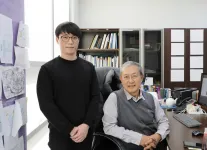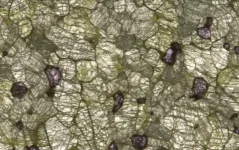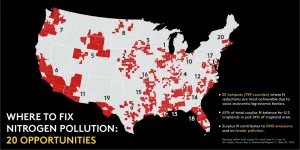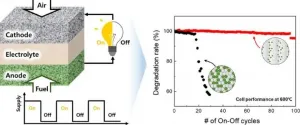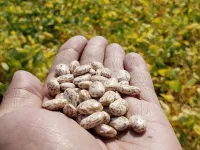(Press-News.org) With every passing day, human technology becomes more refined and we become slightly better equipped to look deeper into biological processes and molecular and cellular structures, thereby gaining greater understanding of mechanisms underlying diseases such as cancer, Alzheimer's, and others.
Today, nanoimaging, one such cutting-edge technology, is widely used to structurally characterize subcellular components and cellular molecules such as cholesterol and fatty acids. But it is not without its limitations, as Professor Dae Won Moon of Daegu Gyeongbuk Institute of Technology (DGIST), Korea, lead scientist in a recent groundbreaking study advancing the field, explains: "Most advanced nanoimaging techniques use accelerated electron or ion beams in ultra-high-vacuum environments. To introduce cells into such an environment, one must chemically fix and physically freeze or dry them. But such processes deteriorate the cells' original molecular composition and distribution."
Prof. Moon and his team wanted to find a way to avoid this deterioration. "We wanted to apply advanced nanoimaging techniques in ultra-high-vacuum environments to living cells in solution without any chemical and physical treatment, not even fluorescence staining, to obtain intrinsic biomolecular information that is impossible to obtain using conventional bioimaging techniques," Dr. Heejin Lim, a key member of the research team, explains. Their novel solution is published in Nature Methods.
Their technique involves placing wet cells on a collagen-coated wet substrate with microholes, which in turn is on top of a cell culture medium reservoir. The cells are then covered with a single layer of graphene. It is the graphene that is expected to protect the cells from desiccation and cell membranes from degradation.
Through optical microscopy, the scientists confirmed that, when prepared this way, the cells remain viable and alive up to ten minutes after placing in an ultra-high-vacuum environment. The scientists also performed nanoimaging, specifically, secondary ion mass spectrometry imaging, in this environment for up to 30 mins. The images they captured within the first ten minutes paint a highly detailed (submicrometer) picture of the true intrinsic distribution of lipids in their native states in the cell membranes; for this duration, the membranes underwent no significant distortion.
With this method too, however, a cascade of ion beam collisions at a point on the graphene film can create a big enough hole for some of the lipid particles to escape. But while this degradation to the cell membrane does occur, it is not significant within the ten-minute window and there is no solution leakage. Further, the graphene molecules react with water molecules to self-repair. So, overall, this is a great way to learn about cell membrane molecules in their native state in high resolution.
"I imagine that our innovative technique can be widely used by many biomedical imaging laboratories for more reliable bioanalyses of cells and eventually for overcoming complex diseases," says Prof. Moon.
Will this innovation become the norm? Only time will tell!
INFORMATION:
Reference
Authors: Heejin Lim¬1, Sun Young Lee1, Yereum Park2, Hyeonggyu Jin3, Daeha Seo3, Yun Hee Jang2 and Dae Won Moon1,4
Title of original paper: Mass spectrometry imaging of untreated wet cell membranes in solution using single-layer graphene
Journal: Nature Methods
DOI: https://doi.org/10.1038/s41592-020-01055-6
Affiliations: 1Department of New Biology, DGIST, Daegu, Republic of Korea
2Department of Energy Science and Engineering, DGIST, Daegu, Republic of Korea
3Department of Emerging Materials Science, DGIST, Daegu, Republic of Korea
4School of Undergraduate Studies, DGIST, Daegu, Republic of Korea
*Corresponding author's email: dwmoon@dgist.ac.kr
About Daegu Gyeongbuk Institute of Science and Technology (DGIST)
Daegu Gyeongbuk Institute of Science and Technology (DGIST) is a well-known and respected research institute located in Daegu, Republic of Korea. Established in 2004 by the Korean Government, the main aim of DGIST is to promote national science and technology, as well as to boost the local economy.
With a vision of "Changing the world through convergence", DGIST has undertaken a wide range of research in various fields of science and technology. DGIST has embraced a multidisciplinary approach to research and undertaken intensive studies in some of today's most vital fields. DGIST also has state-of-the-art-infrastructure to enable cutting-edge research in materials science, robotics, cognitive sciences, and communication engineering.
Website: https://www.dgist.ac.kr/en/html/sub01/010204.html
About the authors
Dr. Dae Won Moon is Professor at the Department of New Biology and is affiliated to the NanoBio Imaging Laboratory at DGIST. He began his career with a PhD in Chemistry from Pennsylvania State University, USA, in 1984, and is now on the editorial board of the journal Critical Reviews in Solid State and Materials Science. His research interests include coherent Raman scattering, surface plasmon resonance imaging ellipsometry, imaging mass spectrometry, and time-of-flight medium energy ion scattering. For his exceptional contribution to the field, including over 180 publications, he has won several awards in Korea.
Messenger RNA (mRNA) vaccines to prevent COVID-19 have made headlines around the world recently, but scientists have also been working on mRNA vaccines to treat or prevent other diseases, including some forms of cancer. Now, researchers reporting in ACS' Nano Letters have developed a hydrogel that, when injected into mice with melanoma, slowly released RNA nanovaccines that shrank tumors and kept them from metastasizing.
Cancer immunotherapy vaccines work similarly to mRNA vaccines for COVID-19, except they activate the immune system to attack tumors instead of a virus. These vaccines contain mRNA that encodes proteins made specifically by tumor cells. When the mRNA enters antigen-presenting cells, they begin making the tumor protein and displaying it on their surfaces, ...
Swimming in indoor or outdoor pools is a healthy form of exercise and recreation for many people. However, studies have linked compounds that arise from chlorine disinfection of the pools to respiratory problems, including asthma, in avid swimmers. Now, researchers reporting in ACS' Environmental Science & Technology have found that using a complementary form of disinfection, known as copper-silver ionization (CSI), can decrease disinfection byproducts and cell toxicity of chlorinated swimming pool water.
Disinfecting swimming pool water is necessary to inactivate harmful pathogens. Although an effective ...
Washington, February 17, 2021--As higher education institutions worldwide transition to new methods of instruction, including the use of more pre-recorded videos, in response to the COVID-19 pandemic, many observers are concerned that student learning is suffering as a result. However, a new comprehensive review of research offers some positive news for college students. The authors found that, in many cases, replacing teaching methods with pre-recorded videos leads to small improvements in learning and that supplementing existing content with videos results in strong learning benefits. The study ...
Geologists have developed a new theory about the state of Earth billions of years ago after examining the very old rocks formed in the Earth's mantle below the continents.
Assistant Professor Emma Tomlinson from Trinity College Dublin and Queensland University of Technology's Professor Balz Kamber have just published their research in leading international journal, Nature Communications.
The seven continents on Earth today are each built around a stable interior called a craton, and geologists believe that craton stabilisation some 2.5 - 3 billion years ago was critical to the emergence of land masses on Earth.
Little is known about how cratons and their supporting ...
A pioneering study of U.S nitrogen use in agriculture has identified 20 places across the country where farmers, government, and citizens should target nitrogen reduction efforts.
Nitrogen from fertilizer and manure is essential for crop growth, but in high levels can cause a host of problems, including coastal "dead zones", freshwater pollution, poor air quality, biodiversity loss, and greenhouse gas emissions.
The 20 nitrogen "hotspots of opportunity" represent a whopping 63% of the total surplus nitrogen balance in U.S. croplands, but only 24% of U.S. cropland area. In total, ...
Modern medical technology is helping scholars tell a more nuanced story about the fate of an ancient king whose violent death indirectly led to the reunification of Egypt in the 16th century BC. The research was published in Frontiers in Medicine.
Pharaoh Seqenenre-Taa-II, the Brave, briefly ruled over Southern Egypt during the country's occupation by the Hyksos, a foriegn dynasty that held power across the kingdom for about a century (c. 1650-1550 BCE). In his attempt to oust the Hyskos, Seqenenre-Taa-II was killed. Scholars have debated the exact nature of the pharaoh's death since his mummy was first discovered and studied in the 1880s.
These and subsequent examinations -- including an X-ray study in the 1960s -- noted the dead king had suffered several severe head injuries but no ...
Although interest in studying prosocial behaviors among U.S. Latinx individuals has increased recently, there is still limited existing research with this population. Evidence shows that prosocial behaviors (actions intended to benefit others) are a marker of healthy social functioning and can both support positive development (such as academic achievement) and mitigate problematic outcomes (such as anxiety and depression). An important question is whether prosocial behavior is fostered by parents in ways that are specific to their cultural groups or through more universal aspects of parenting. A new longitudinal study in the United States examined relations among parenting, culture, and prosocial behaviors in U.S. Mexican youth.
The findings were published in a Child ...
Children raised in neighborhoods with low socio-economic status are at risk for low academic achievement. A new longitudinal study followed young children from such neighborhoods from birth until age seven to explore whether children's capacity to act kindly or generously towards others (prosocial behavior) - including peers, teachers, and family - is linked to their ability to perform well in school. The study showed that prosocial behavior may mitigate academic risk across early childhood.
The findings were published in a Child Development article written by researchers at Stanford University and the University of Leeds, and the Bradford Institute for Health Research.
"Identifying factors that can help children achieve academic ...
A research team in Korea has developed a ceramic fuel cell that offers both stability and high performance while reducing the required amount of catalyst by a factor of 20. The application range for ceramic fuel cells, which have so far only been used for large-scale power generation due to the difficulties associated with frequent start-ups, can be expected to expand to new fields, such as electric vehicles, robots, and drones.
The Korea Institute of Science and Technology (KIST) announced that a team led by Dr. Ji-Won Son at the Center for Energy Materials Research, through joint research with Professor Seung Min Han at the Korea Advanced Institute of Science and Technology (KAIST), has developed a new technology ...
Your morning cereal or oatmeal. The bread on your sandwich. The corn chips for your snack, and the cookies for dessert. Not one would be possible with the humblest of ingredients: the seed.
Seeds such as wheat, rice and corn directly provide about 70% of the calories eaten by people every day. And they ultimately provide nearly every morsel of food, either by providing feed for livestock or by being grown into fruits and vegetables. It's no overstatement to say that without seeds, civilization would be impossible.
But seeds need our help. They are under stress from climate change, and under pressure to feed a growing population.
Scores ...
